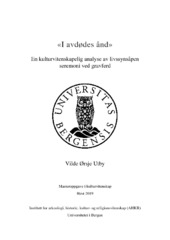| dc.contributor.author | Utby, Vilde Ørsje | |
| dc.date.accessioned | 2019-10-02T11:42:03Z | |
| dc.date.available | 2019-10-02T11:42:03Z | |
| dc.date.issued | 2019-10-01 | |
| dc.date.submitted | 2019-09-30T22:00:03Z | |
| dc.identifier.uri | https://hdl.handle.net/1956/20897 | |
| dc.description.abstract | In Norway there are two kinds of funeral ceremonies: Religious funeral ceremonies and nondenominational funeral ceremonies. The first group includes funerals that are arranged through a religion or a philosophy, where the Christian funeral ceremony and the humanistic funeral ceremony can be placed. The second group includes funerals that are not arranged through a religion or a philosophy. Up to 2012 the second group consisted of a funeral ceremony called “personal ceremony”, when the Ministry of Culture attracted more focus to these kinds of funeral ceremonies, and introduced «livssynsåpen seremoni ved gravferd». In translation this ceremony is “personalised funeral ceremonies”. This ceremony focus on the deceased, rather than a religion or a philosophy. This kind of ceremony is in focus in this thesis. In the latter funeral ceremonies there may be as much or as little religion as the deceased or/and the relatives want. It can be nondenominational or it can be a multi faith funeral. In this thesis the aim is to explore what happens with the funereal ceremony when it is not arranged by a religion or a philosophy. Essential questions are: In which way do traditions in funeral ceremonies change in a personalised ceremony? How can a personalised ceremony be arranged? What is important for the relatives to include in the ceremony? Historically there has been a development in funeral rituals and people’s attitude towards death. Philosopher Philippe Ariès has explored the changes in the attitude people has towards death from the Middle Ages and up to the late 20th century. He introduced four main phases in this timeline, where the changes can be seen. Not long after a fifth phase was supplied and described by sociologist Michael Hviid Jacobsen, and it is in this phase this study is placed. Since the rituals have changed with social development I will take inspiration from sociologist Anthony Giddens modernity theory, to see why this ceremony has developed. Modernity and tradition are understood as two contrary parts, but are also depending on each other. Funeral rituals have a long tradition, and the terms “tradition” and “ritual” are both central in the study. This is a qualitative study, based on eleven interviews and four observations. The interviews involve three bereaved, who arranged a personalised funereal ceremony, and eight masters of ceremonies. Several of the masters have experience with Christian funeral ceremonies or humanistic funeral ceremonies. | en_US |
| dc.language.iso | nob | |
| dc.publisher | The University of Bergen | |
| dc.rights | Copyright the Author. All rights reserved | |
| dc.subject | personalised funeral ceremony. | |
| dc.subject | Seremoni | |
| dc.subject | tradition | |
| dc.subject | death | |
| dc.subject | død | |
| dc.subject | tradisjon | |
| dc.subject | modernity | |
| dc.subject | modernitet | |
| dc.subject | livssynsåpen | |
| dc.subject | gravferdsseremoni | |
| dc.subject | ceremony | |
| dc.subject | ritual | |
| dc.subject | gravferd | |
| dc.title | «I avdødes ånd». En kulturvitenskapelig analyse av livssynsåpen seremoni ved gravferd | |
| dc.title.alternative | “In the spirit of the deceased”. A cultural studies analysis of personalised funeral ceremonies | |
| dc.type | Master thesis | |
| dc.date.updated | 2019-09-30T22:00:03Z | |
| dc.rights.holder | Copyright the Author. All rights reserved | |
| dc.description.degree | Mastergradsoppgave i kulturvitenskap | |
| dc.description.localcode | MAHF-KUVI | |
| dc.description.localcode | KUVI350 | |
| dc.subject.nus | 713412 | |
| fs.subjectcode | KUVI350 | |
| fs.unitcode | 11-22-0 | |
